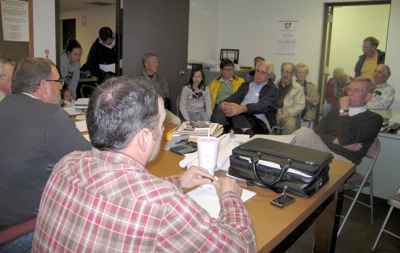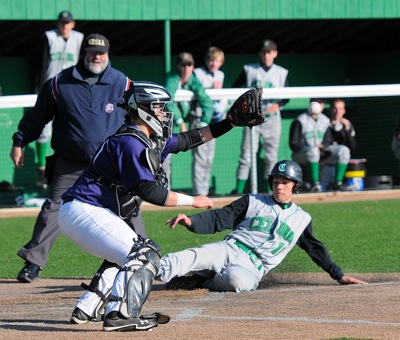Tuesday, March 27th, 2012
Hatching the catch
By Amy Kronenberger
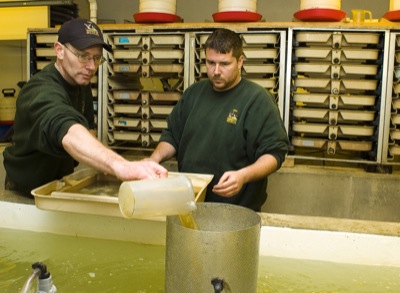
Photo by Mark Pummell/The Daily Standard
St. Marys State Fish Hatchery employees Jay Williams, left, and Adam Sawmiller transfer yellow perch from heated trays to a larger tank as they separate the fish from their egg ribbon.
ST. MARYS - The hunt for eggs has begun.
Workers at the St. Marys State Fish Hatchery are collecting and fertilizing fish eggs. Some already have hatched.
"Fish season begins right now," hatchery superintendent Morton Pugh said.
The hatchery - 43 acres of ponds in Grand Lake's backyard - breeds walleye, saugeye, yellow perch and channel catfish to stock in waters across Ohio. They also breed fathead minnows to supply forage for the fish bred at St. Marys and at other hatcheries.
Pugh said one of the key components to successful breeding is maintaining healthy water quality in the ponds. The hatchery on Feeder Road on the east side of Grand Lake uses water from the lake and from a well dug two years ago after the state issued water quality advisories on the lake due to toxic blue-green algae blooms.
Another well is being dug this year.
"I need good water to raise fish, and if the water quality doesn't improve, we'll have to use the well," he said. "But we try to use lake water as much as possible because the lake has natural-needed nutrients and phyto and zooplankton that the fish feed on."
Nutrients are added when well water is used.
"It's really critical for us to keep that greenish color to our ponds," Pugh said. "It's just like fertilizing your grass, only we're fertilizing the water so that the phyto and zooplankton can grow."
Workers monitor oxygen levels daily through the winter months. Aerators are turned on to restore balance if levels are too low.
From about April 15 to June 10, depending on weather and water conditions, Pugh and his staff will analyze nutrient levels daily to make sure the water quality is acceptable.
"Spring water quality is usually fine," he said. "It's in the summer, about June, when it starts to go bad, and we have to switch to well water."
The hatchery stocks perch all year and recently began the breeding process. The fish are injected with a hormone so they spawn at the same time.
The perch are squeezed to release their egg ribbons, Pugh said. The ribbons are placed on chicken wire and agitated to break apart individual eggs. This year, the hatchery has new heated trays to store the ribbons.
The perch eggs hatch after about seven to 12 days. They typically stock 250,000 to 300,000 perch hatchlings - or fry - in the ponds.
Also in the spring, hatchery workers will take boats to the Maumee River in northwest Ohio to collect walleye eggs.
"We'll run a current through the water that paralyzes the fish for a short time," Pugh said. "The fish are netted and the eggs are taken out. Then the fish are returned to the river."
About 125 quarts of the eggs are fertilized with male walleye milk, and about 150 quarts of eggs are fertilized with male sauger milk shipped to the hatchery in vials from The Ohio State University. Interbreeding the walleye with the sauger creates the sterile saugeye.
"We breed the saugeye because they are heartier and larger than walleye, and they can handle dirtier, more turbid waters," Pugh said.
Pugh said the eggs have about a 50 percent survival rate in the hatchery. They have about a 5 percent survival rate in the wild.
The fertilized walleye and saugeye eggs are stored in large jars with 300,000 to 400,000 eggs. They hatch in about 10-14 days, and the fry are transferred to tanks for three to five days before being placed in the ponds.
The walleye, saugeye and perch are held in the ponds until they reach about 1 3/4 to 2 1/2 inches in length, or fingerling stage. In May or June, the ponds are drained, and the fish are stocked in area public waterways, including Lake Loramie, Indian Lake and Bresler Reservoir near Lima.
Stocking the fish at Grand Lake stopped two years ago when the toxic blue-green algae bloomed. The state won't stock the lake this year.
"We've decided to put stocking on hold until things are figured out and the water is determined safe," Pugh said.
In June, the ponds will be refilled and stocked with channel catfish and muskies bred at other hatcheries. The fish will be raised and distributed to lakes in the fall. The hatchery also sometimes raises largemouth bass during the summer.
"We usually release about 60,000 yearling catfish," Pugh said. "We don't raise many bass, usually about 3,000 to 5,000 and not every year."
The state's six hatcheries are funded partially by taxes paid on boats, fishing licenses and equipment.
"So every time someone buys equipment for fishing, they are supporting the production of the fish they're catching," Pugh said.
Besides fish production, the hatchery is known as an excellent destination for birdwatchers; the ponds attract many species of waterfowl. An archery range located on the grounds is another popular attraction.
The public can visit the grounds anytime. The facility is open 8 a.m.-3 p.m. weekdays and is available for tours.
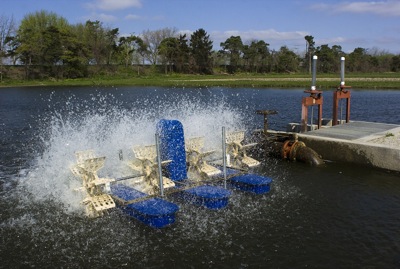
Photo by Mark Pummell/The Daily Standard
An aerator churns the water in one of the ponds, adding needed oxygen to keep fish healthy. Hatchery workers continuously monitor oxygen and nutrient levels to ensure a healthy environment for the fish.
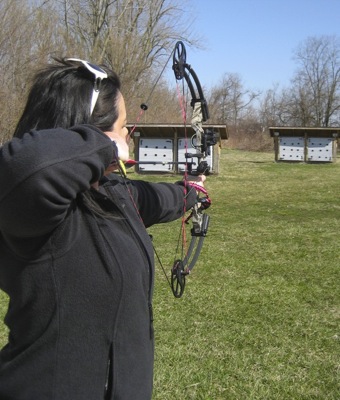
Photo by Mark Pummell/The Daily Standard
Monica Rupert, St. Marys, takes aim at one of the archery targets behind the hatchery. The range is one of the free attractions at the site.
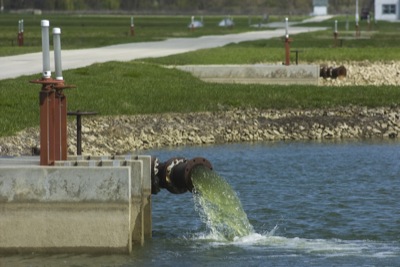
Photo by Mark Pummell/The Daily Standard
Large pipes pump thousands of gallons of lake water into the ponds at the hatchery. Workers will switch to well water in the summer if lake water quality falls.

Submitted Photo
This aerial shot shows the east bank of Grand Lake, left, and all 43 acres of ponds after the facilities' 1996 renovation. The project cost about $1.9 million.




